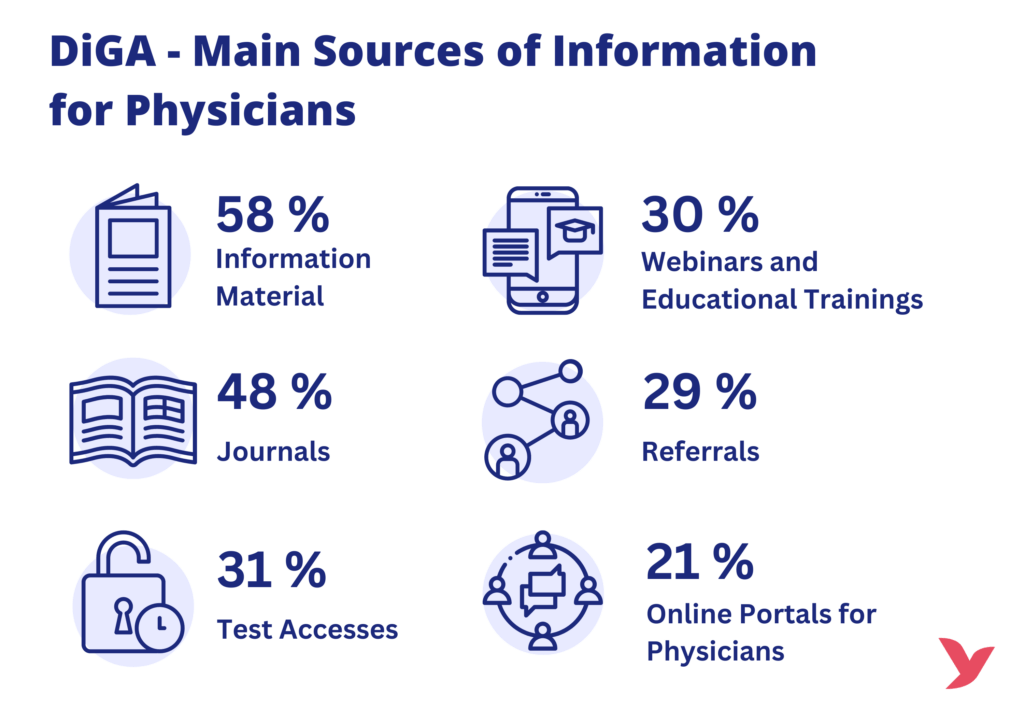Since the launch of the first digital health application (DiGA), it has been shown over and over again that it can be difficult for manufacturers to successfully establish their solutions in the market, and all the more to convince their customers of their product. A survey by Stiftung Gesundheit highlights this issue from the perspective of medical professionals and shows clearly: doctors still have concerns and question marks when it comes to prescribing digital therapies. The most frequently mentioned factors were concerns about data protection and efficacy.

These issues assign a clear task to DiGA manufacturers: to provide prescribers with the urgently needed information about their producrs while at the same time dispelling prejudices and misconceptions. Therefore, understanding the information channels of patients and their doctors is a crucial factor. Looking at the previously mentioned survey, the main sources for information from a doctors’ perspective are still medical journals and inormation materials provided by manufacturers. In the case of digital applications, also test accesses play a decisive role as many doctors are dealing with this new form of therapy for the first time and want to get a comprehensive picture before the first prescription.

- Physicians: For most manufacturers, it is important to get in touch with potential prescribers at an early stage to understand their needs and expectations. Experience shows that mainly traditional information channels are used by this target group and new offers such as a digital sales force or webinars fall short of expectations. To set up the most targeted distribution possible, manufacturers should think through exactly which group of doctors (GP vs. specialist) would be responsible for a prescription and how the DiGA fits into their treatment pathway.
- Patients: While direct B2C marketing is common practice in many industries, it doesn’t seem to fit into the healthcare market at the first galnce. If you take a look at classical medicines and drugs, advertising to so-called laypeople is excluded under the German Drug Advertising Act (Heilmittelwerbegesetz, HWG). However, the situation is different with DiGAs: since they are a medical product, much more is possible in terms of marketing and sales. In addition to doctors, patients as a target group can be directly addressed with the medical information and can thus serve as a driver for a medical prescription. At the same time, they can be informed about the possibility of using a DiGA as a treatment option directly via the health insurance companies.
- Industry collaborations: Navigating the complex German health ecosystem is not always easy for DiGA manufacturers – especially for those with a more technical background or who are entering the market from abroad. Especially accessing prescribing doctors is difficult and in the most cases is only possible through years of extensive relationship building. At this point, industry partnerships, e.g. with pharmaceutical companies experienced in sales, can offer real added value for DiGA manufacturers. A good example here is the pharmaceutical company Servier, which has been fully responsible for the distribution of the depression DiGA deprexis for several years. With other manufacturers, a synergy, for example through joint marketing (companion patella), can act as a catalyser for product sales.
Our learning at Flying Health: DiGA manufacturers need a targeted marketing strategy to successfully establish their digital solutions on the market. Therefore, they have to develop an understanding of their own target groups and to approach them with a precisely tailored marketing offer. Not only the information material itself is crucial, but also the selected communication channels and distribution partners. Already during product development, but at the latest during the DiGA Fast Track process, manufacturers should have a solid concept for their product marketing in order to maximize the chances of success for their solutions.